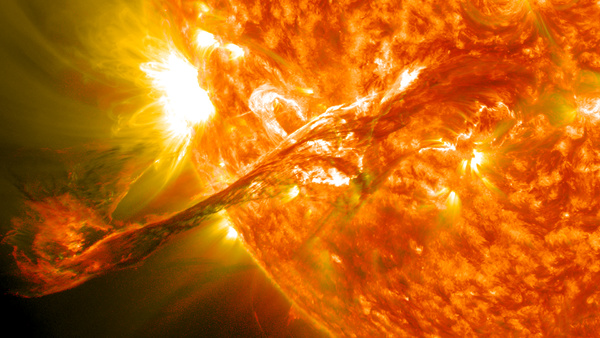|
researchers at the university of colorado – boulder have discovered that coronal mass ejections (cme), which release electrically charged plasma from then sun, create shock waves similar to an airplane creating a sonic boom that can heat the upper atmosphere or earth, but that the shock waves also cause nitric oxide to form, which in turn rapidly cools the atmosphere.

a recent study shows that the upper atmosphere naturally overcools when impacted by cem.
(wikimedia commons)
according to a report on the school’s website, cme can cause the atmosphere to jump in temperature by as much as 750°f, but nitric oxide can cool it by 930°f.
the article added, “because the upper atmosphere expands during cmes, satellites in low-earth orbit are forced to move through additional gaseous particles, causing them to experience more drag. satellite drag – a huge concern of government and aerospace companies – causes decays in the orbits of spacecraft, which subsequently burn up in the atmosphere.”
as an article from physics today added, “those currents and particles heat the tenuous atmosphere—hundreds of kilometers in altitude—which then expands outward. low-orbiting satellites should thus experience more drag. but measurements of their orbital decay reveal that the drag from cmes isn’t always as great as expected.”
researchers used 15-year data sets from the sounding of the atmosphere using broadband emission radiometry (saber) instrument on nasa’s timed satellite and from u.s. department of defense satellites.
“geomagnetic storms have had severe impacts on earth,” the university’s article explained. “a 1989 storm caused by a cme resulted in the collapse of the hydro-quebec’s electricity transmission system, causing six million canadians to lose power. in 1859 a solar storm called the carrington event produced auroras from the north pole to central america and disrupted telegraph communications, even sparking fires at telegraph offices that caused several deaths.”
the research was published in space weather. the abstract stated:
“we present a multiyear superposed epoch study of the sounding of the atmosphere using broadband emission radiometry nitric oxide (no) emission data. no is a trace constituent in the thermosphere that acts as cooling agent via infrared (ir) emissions. the no cooling competes with storm time thermospheric heating, resulting in a thermostat effect.
“our study of nearly 200 events reveals that shock-led interplanetary coronal mass ejections (icmes) are prone to early and excessive thermospheric no production and ir emissions. excess no emissions can arrest thermospheric expansion by cooling the thermosphere during intense storms. the strongest events curtail the interval of neutral density increase and produce a phenomenon known as thermospheric ‘overcooling.’
“we use defense meteorological satellite program particle precipitation data to show that interplanetary shocks and their icme drivers can more than double the fluxes of precipitating particles that are known to trigger the production of thermospheric no. coincident increases in joule heating likely amplify the effect.
“in turn, no emissions are more than double. we discuss the roles and features of shock/sheath structures that allow the thermosphere to temper the effects of extreme storm time energy input and explore the implication these structures may have on mesospheric no. shock-driven thermospheric no ir cooling likely plays an important role in satellite drag forecasting challenges during extreme events.”
|